Table of Contents
During your regular groceries shopping, you can find many aisles and shelves with delicious FIT breakfast cereals. Next to them, you see strawberry flavour milk and just above it sits the popular low-fat yogurt you’ve seen on TV. But even here, everything is not as it seems. Lots of these foods act like they are super healthy and often even suitable for weight loss.
You can find many similar cases like this in the store. However, the nutritional profile of individual products can have a major impact on your weight, as well as overall health. That’s why it’s important to know which foods are really worth it and which only seem healthy. [1]
Selection of foods that can make a seemingly healthy impression
Sometimes it can be quite difficult to tell at a glance whether the product you are holding is healthy or not. The golden rule remains to read at least the nutrition label. If it contains a large amount of sugars, saturated or unhealthy trans-unsaturated fats, salt or a suspiciously high amount of calories per serving, it’s probably not healthy. Another clue can be the ingredients list, especially if the length of it is reminiscent of the book series Games of Thrones. So, let’s take a look at examples of foods that only look healthy.
1. Some types of breakfast cereals, muesli or granola
Breakfast muesli cereals are for many a perfect example of a healthy breakfast. They often attract with various fitness slogans, which in the end can be misleading. On top of that, it has a beautiful packaging, decorated with a photo of a slim fitness model, enticing you with a smile on her face to buy this “healthy” product. If you look closely at the ingredients list, you may find that many such breakfast cereals, muesli or granola contain a large amount of added sugar. These products are also often low in fibre or protein. In some cases, such product can be compared to regular sweets.
What is the difference between the popular granola, muesli or breakfast cereals?
- Highly processed breakfast cereals: They are often the least healthy because they contain highly industrially processed grains, are low in protein, vitamins and high in sugar. The refining process also depletes them of the amount of fibre that is beneficial for the digestion. It is precisely for these factors that this is not a healthy choice that does not meet several criteria of a healthy diet. In addition, such breakfast cereals could cause problems in the future due to excessive intake of sugar, which they contain in large quantities. Such products include mainly popular chocolate bits, cinnamon crumbs and the like. They are often enriched with a large amount of extra sugar and added colouring agents. Although some of them may be enriched with vitamins, the amount of sugar they contain is still quite high.
- Muesli: in addition to their high sugar content, muesli are often enriched with various additives. However, healthy muesli should only contain cereals with some fruit, nuts and seeds.
- Granola (baked muesli): often contain added sugar and large amounts of calories. However, some types may also be high in fat. Most granola contain nuts, the source of healthy fats, but still this kind of breakfast meal should be consumed in moderation. It usually has the same ingredients as muesli, but the difference is that granola is baked (adding some coconut oil, melted butter). That’s how it gets its typical crunchiness. [2–3] [18]
Therefore, choosing breakfast cereals, muesli or granola may not be as healthy as it may seem at first glance. The World Health Organisation is considering tightening the limits for the consumption of added sugars from 10% CEP (total energy intake) to 5%. For an adult, this value is on average 30 grams per day, which you can easily exceed just after having some cereals for breakfast. Excessive sugar consumption is also associated with an increasing risk of obesity. It also contributes to negative changes in the metabolism of fats and carbohydrates. That’s why overall daily sugar intake should be limited. [19–21]

What to do about that?
Before buying breakfast cereals, it is important to always check the ingredients list of the product itself. Pay attention to the amount of sugar, protein, but also the total calorie content. Most healthy products are typically not highly industrially processed. They usually contain less ingredients. [3–4] [22]
How to choose cereals, granola or muesli?
Try to choose breakfast cereals that:
- have as little added sugar as possible, ideally none
- contain fiber
- are rich in protein
For muesli and granola, you should pick those that:
- contain whole grains (e.g. oats, rye, wheat, barley), thanks to which they contain more antioxidants, minerals and fibre than their refined versions
- are low in sugar, which is used as a binder, especially in granola. Its value should ideally be as low as possible;
- have a low content of saturated fats – muesli and granola with nuts and seeds contain mostly healthy fats. However, saturated fats from various vegetable oils, which are used to enhance the taste, are not that healthy at all;
- have a low salt content;
- are high in protein;
- contain fiber;
- contain only the necessary minimum of added ingredients;
2. Fitness bars
Fitness bars also belong to the category of very popular foods, and new ones are popping up every day. They are often referred to as “healthy”, although this may not be the case at all. People like to snack on bars during their trip or a hectic day. However, fitness bars might be hiding some ingredients in a similar way to breakfast cereals.
You guessed it right. The problem is the large amount of added sugar, fat, but also a small amount of protein and fibre. It is often the industrially processed high-fructose corn syrup (HFCS). It is a cheaper raw material for manufacturers than classic rapeseed or cane sugar. Not only that, but it is even worse when the bar is coated in chocolate. The content of sugars and unhealthy fats in this case can easily increase even more. [5]
You might be interested in these products:
What to do about that?
If you only eat some fitness bar once in a while, it probably won’t hurt you in any way. It can be great for quick energy replenishment during sports performance, when you have a large expenditure of energy. Such sports include hiking, cycling and so on. However, it should not replace whole foods, and people who do not have enough exercise should be careful with their consumption. For example, try an apple, banana or other piece of fruit as a quick snack, ideally with some dairy product (skyr, cottage cheese, etc.). Greek yogurt with oats can also be a great choice. In many cases, fitness bars can be replaced by protein bars, which offer a high protein content and will fill you up for longer.
A protein bar is an ideal quick snack, as it typically contains less sugar, more fibre and can easily satisfy sweet cravings. However, it is also important to check the label and nutritional values.
3. Some instant breakfast porridges
Instant porridge is a very popular meal to start the day because it is so easy to prepare. Usually, all you have to do is pour hot water, mix it up and the breakfast is served. But even in this case, I have to disappoint you because such breakfast meal may not be as healthy as it seems.
Many people get used to adding sugar, honey, sweet syrup or other ingredients to instant porridge, which turns a healthy breakfast into a sweet dessert. Not to mention that many instant porridges already contain increased amounts of added sugar to simply make it taste better. In the ingredients list, you can easily come across unnecessarily high amounts of added salt and unhealthy artificial colours. What’s more, an instant porridge often contains a small amount of protein and fibre. [6]

What to do about that?
Similarly to the previous cases, you should read the ingredients list of the breakfast porridge you want to buy. Try to choose one that does not contain added sugar or a high proportion of salt, ideally none. Again, make sure that the porridge is rich in protein and fibre.
To make it a more complex meal, you can enrich a porridge bowl with protein with, for example, by adding some whey protein. Adding more protein is also important for muscle growth and the feeling of satiety. You can also add favourite fruits, thanks to which you can enrich it with fibre, vitamins or minerals. Also try adding flax seeds, chia or peanut butter, and enrich your porridge with healthy fats and fibre. [6]
4. Flavoured dairy products and certain low-fat products
Dairy products have a relatively good reputation among healthy foods. It is true that their quality has increased significantly in recent years. However, you may still find some low-fat and flavoured dairy products that contain too much added sugar and other unhealthy ingredients. For example, yoghurts can contain excessive amounts of thickeners, starch or even sugar.
The already mentioned unhealthy ingredients are contained in most low-fat yoghurts to make their consistency thick even after most of the fat is removed. The disadvantage of flavoured dairy products is that they often contain additives which can bring even more sugar. It can be the case with various yoghurts or milk. The sugar in them primarily acts as a preservative for the fruit component and also improves the final taste. [7]
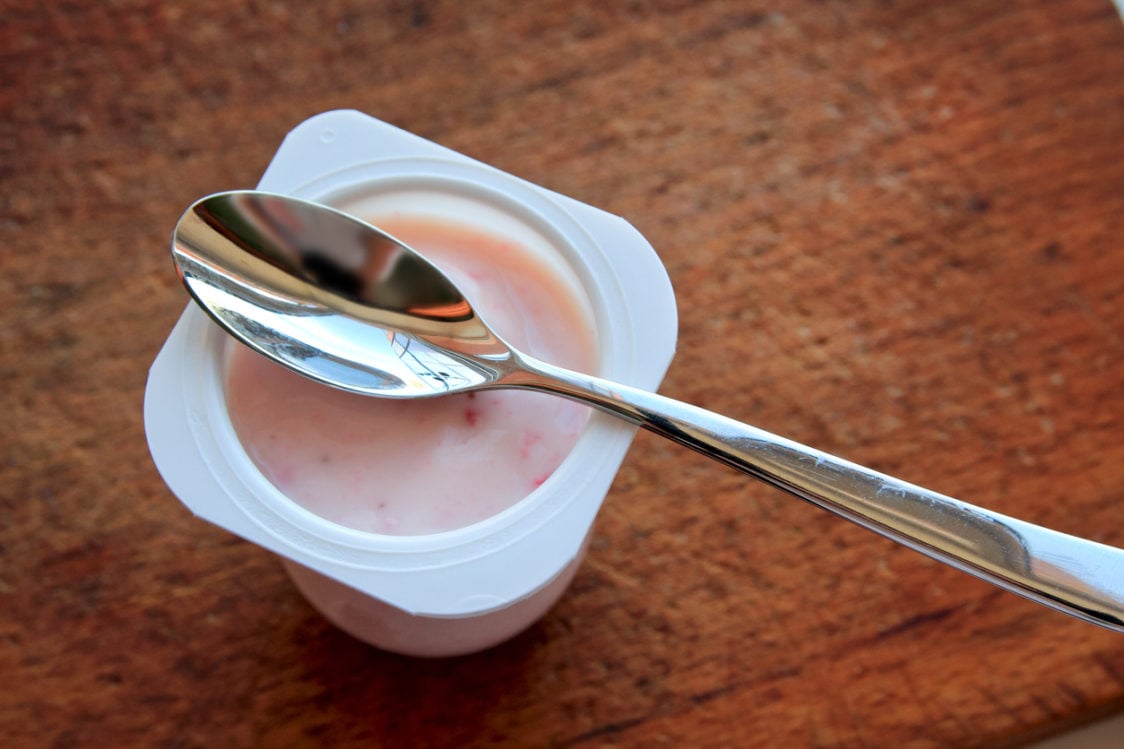
What to do about that?
Low-fat and flavoured dairy products are a broad group of foods and can differ from one to another. Before judging anything, you should always look at the ingredients list and nutritional values of the product. If, for any reason, you don’t like white full-fat yoghurt, you can choose a high-quality, low-fat alternative. It can often contain even more protein or calcium than the full-fat version. However, focus on a pure dairy product that is sugar-free or contains as little added sugar as possible.
0% Greek yoghurt or no-fat cottage cheese are perfectly fine in this regard. To improve their taste, you can try adding fruit or BIO Banana Powder, sugar-free, calorie-free sauces or Flavor Drops. So, before reaching for a flavoured dairy product, try to buy its unflavoured version, and add any ingredients you like. You will get a well-balanced and satiating snack.
However, you can also reach for whole milk or yogurt. The differences between them and the low-fat versions are almost minimal. Whole milk or yogurt taste better and also make you feel fuller. But keep in mind that they must fit into your balanced diet.
Sour milk products are also healthy choice. They are more easily digested and have a lower milk sugar (lactose) content. This is one of the reasons why they are popular among people with lactose intolerance. However, their main advantage is the high content of probiotics, living microorganisms.
Probiotics are also naturally found in our digestive tract. In sufficient amount, they can have a positive effect on our health. However, if you love cheese, it is important to keep an eye on its fat content in particular. Try to choose cheese that contains up to 30% fat, or even less. The advantage of low-fat cheese is then not only a lower fat content, but often also a slightly higher protein content. [8]
5. Fruit juice
Fruit juice is considered by many people to be a healthy drink, perfect to enjoy during breakfast, for example. This is based on the fact that juice contains various antioxidants or vitamins. Manufacturers know it and they will try to draw your attention to that fact with distinctive graphics on the product packaging. Yes, it’s nice to have some vitamins in your drink, but don’t forget the fact that fruit juices often contain a large amount of sugar. In many cases, it can even be the same as you find in classic sweetened fizzy drinks.
Equally important is the fact that not all juice drinks are 100% juice. They differ in the way they are processed and what ingredients they contain. [2] [9]
What is the difference between juice and fruit drink?
- fruit drinks are often full of sugar and added colourants
- fruit nectar has 25-50% of the fruit component. The rest of its content consists only of water and added sugar or sweeteners.
- juice is a drink that is often made from fruit concentrate. It is formed by evaporating water from fruit juice and then diluting again with water. The percentage of fruit component can thus be different.
- fruit juice contains 100% juice
Of these drinks, fruit juice (100% juice) is the best choice. However, you should still drink it in moderate amounts. It still contains a lot of natural sugar. Nevertheless, many people like to buy a one litre bottle or box, and drink it all immediately. But keep in mind that this way your intake can easily increase by a few hundred calories. The resulting caloric value can thus be the equivalent of one full meal, which would will you up far more than liquid calories from a fruit juice. [9]
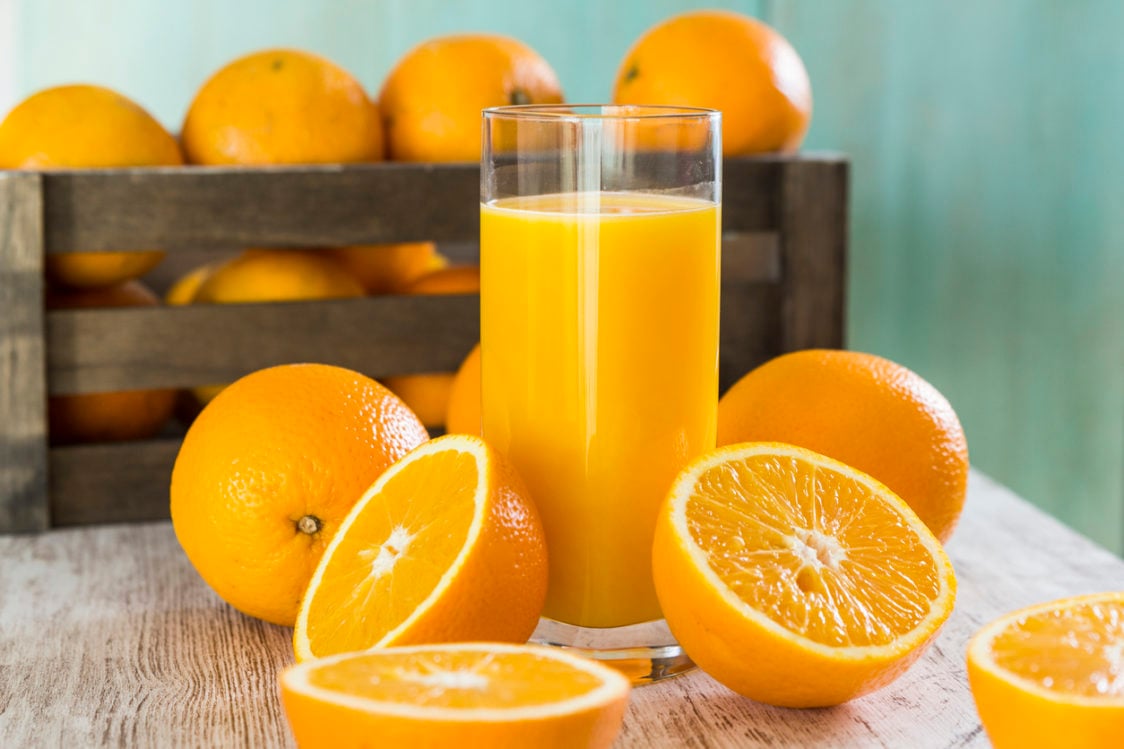
What to do about that?
In the case of fruit drinks, pay particular attention to the amount of added sugar. From a healthy point of view, 100% fruit juice is the best option. It’s actually made up of 100% fruit juice. It should be a completely pure fruit product that does not contain any added sugar, water or other ingredients. So if you want something sweet to drink, 100% fruit juice can be an ideal solution. If you have a glass of juice as part of a balanced healthy diet, while it fits into your total daily intake, it’s perfectly fine. Diluting the juice with water in a ratio of 1:1 can also help. This will allow you to consume fewer calories with a higher volume of drink. [9–10]
You can read more about fruit drinks in the article Where Are Liquid Calories Hidden and How These Empty Calories Prevent You from Losing Weight.
6. Smoothies
Smoothies are an increasingly popular fitness trend. They are often perceived as a super healthy drink that can be prepared at home exactly according to your taste preferences. While the above-mentioned juices are created using the pressing process without a solid component, smoothies are made by blending fruits or vegetables.
The difference between a healthy and unhealthy smoothie depends to a large extent on the quality and quantity of its ingredients, but also on the individual needs of the person. It’s different if you make a smoothie at home, where you have the ingredients under control, or if you buy it in the store. A seemingly innocent “healthy” smoothie you bought can easily become a calorie bomb. This, like fruit juice, can then contribute to an unwanted increase in your total intake by a few tens of grams of sugar and hundreds of calories. In addition, smoothies are often low in protein.
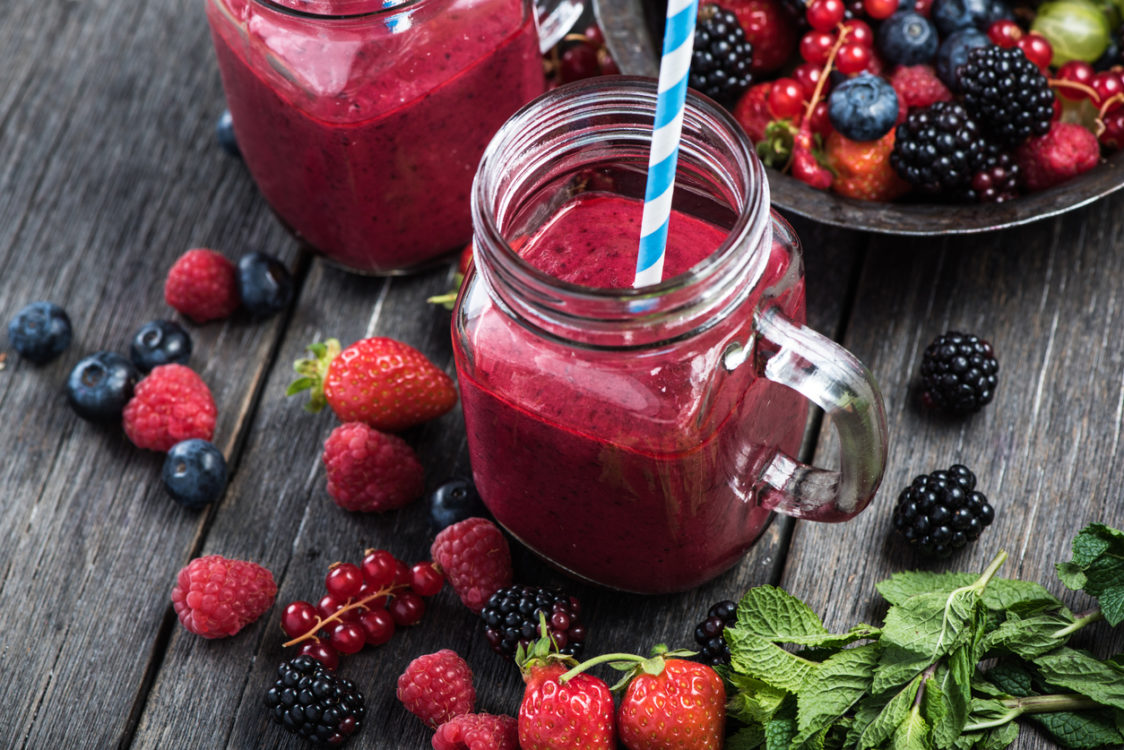
One smoothie can be an equivalent to one extra lunch. Compared to food, however, the smoothie fills you less, which brings a faster arrival of hunger. On the contrary, larger sugar content and partially degraded fibre are not beneficial to our body. [11 – 12]
What to do about that?
Smoothie may not always be an ideal choice. However, be careful to make it fit into your daily caloric intake. For example, during difficult days, when you do not have enough time to eat, a smoothie can easily replace a snack. However, its total amount and nutritional values should be in line with your goals and their corresponding caloric intake. You will be able to control the ingredients of the smoothie easily by preparing it yourself. You don’t even have to put that much fruit in it. For example, mix a piece of banana with a small apple or pear.
Keep in mind that popular ingredients such as juices, sweetened almond drinks or flavoured milk are high in sugar and can easily double the number of calories. If you want a lighter option, try adding water, unflavoured milk, ice or calorie-free flavourings instead. 0% Greek yogurt, a piece of fruit, low-fat cottage cheese or protein can also be a good choice to get a thicker consistency. This way, you will also enrich your smoothie with protein. You can also find inspiration on how to prepare a smoothie in our article 10 Recipes for the Most Popular Smoothie Drinks. [13]
7. Vegetable salads
Vegetable salad is probably the first thing that many think of when they hear “healthy diet”. It’s no surprise, as vegetables are actually very healthy and contain a relatively small amount of calories. However, not everyone enjoys eating vegetables on their own. In order to improve the taste, many reach for various dressings, which can turn a salad into a gourmet speciality in no time.
And the dressings are precisely what can change everything. They often loaded with sugar, vegetable oils, saturated fats, salt and other ingredients. This way, the seemingly innocent vegetable salad suddenly finds itself on the list of unhealthy dishes and becomes an entirely different dish. In addition, its caloric profile can easily compete with a burger. [3]

What to do about that?
Consuming vegetables has countless benefits for our health. However, the combination with caloric dressing greatly undermines all these benefits. The solution may be easier than you would expect. No, you don’t have to eat vegetable salad without dressing and torment with its bland taste. Try to make the dressing yourself so that its ingredients are much healthier. For example, you can use a teaspoon of oil, your favourite herbs, a pinch of salt and balsamic vinegar. Yogurt dressing with mustard and herbs can work great. You can find further inspiration, for example, in our article Fitness Recipes for 11 Healthy and Delicious Salads.
The second solution is to reach for calorie-free sauces. They would not add any extra calories to your vegetable salad. Besides that, they do not contain sugar, fat, gluten or lactose. This is an effective way to help you avoid the calories from regular dressings without having to give up the delicious taste of your vegetable salad.
8. Vegetable chips
Probably each of us knows very well that one beautiful isle in the store, filled with chips. At first glance, however, no one would seek healthy food there. When suddenly, there are some vegetable chips, attracting you with slogans containing words like premium, low fat or healthy. It sounds perfect until the moment you take facts into consideration – vegetable chips may not be any healthier than classic potato chips.
So, why do people buy them? Maybe it’s because of how potato chips are portrayed. They are often presented to us as unhealthy and fatty. Then, when you see a vegetable chips in the store, in your head you immediately connect it with healthy food and you might think that they have nothing to do with potato chips. However, the opposite is true.
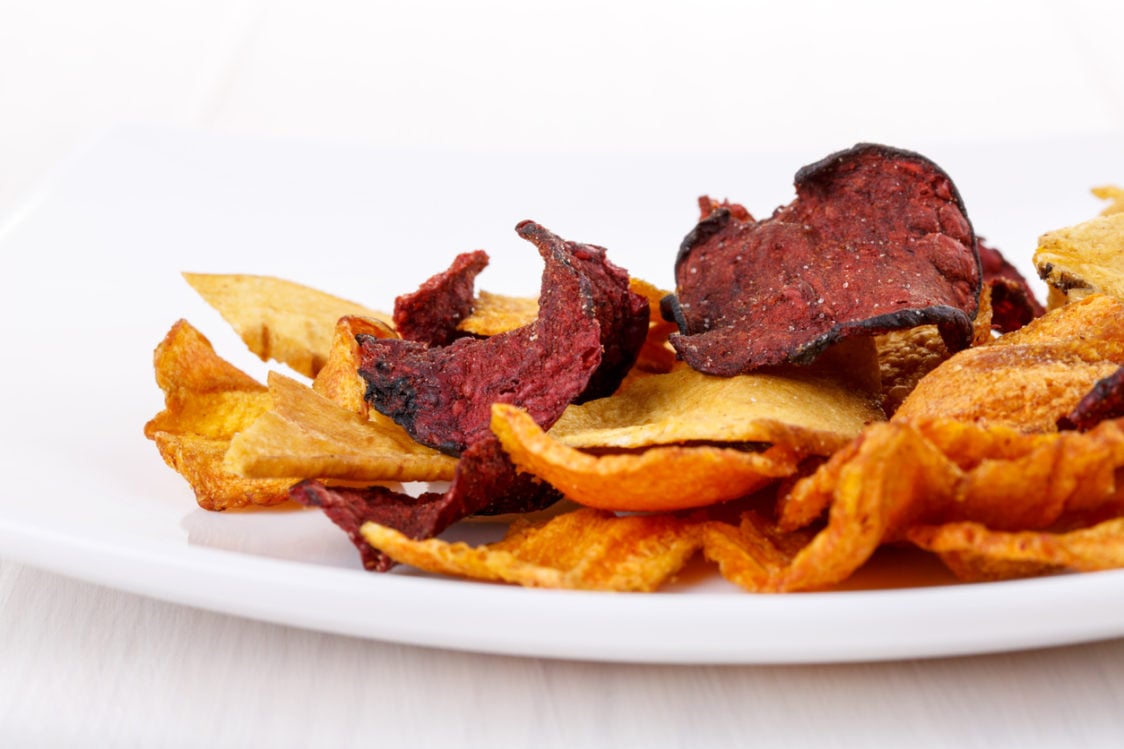
Classic potato chips usually contain potatoes, salt and some kind of vegetable oil – sunflower, rapeseed or corn in most cases. Then there are some flavoured versions of these chips, which are enriched with other ingredients, such as food colourings, sugar, flavourings and aromas. The nutritional values for vegetable chips are almost identical, and sometimes even higher. The caloric difference is usually given by the difference in calories between potatoes and a particular type of vegetable, but also by the method of preparation.
Not to mention that before becoming crunchy chips, fresh vegetables will lose almost all their water content and get a decent amount of oil. As a result, it is a calorie-rich food that is often not healthier at all than classic potato chips. [14]
What to do about that?
Vegetable chips may not be a bad snack, but they are certainly not as healthy as their name may suggest. If you really want some chips, feel free to treat yourself to a smaller portion of the classic potato ones or even the vegetable ones, in accordance with your caloric intake.
In addition, you can try to prepare chips at home. This way you will be in control of the amount of calories they contain. Instead of frying chips in oil, you can try to blanch them and then dry them in a hot air oven. It is also more suitable to use a cooking spray. Whether you buy chips in a store or prepare them yourself, the key is to monitor the fat content. It is still a foodstuff that should be perceived only as a diversification of your diet. [15]
9. Agave syrup
There are people who try to avoid classic sugar in every possible way. So they reach for various alternatives that they use as a sweetener. A very common and popular solution in this case is agave syrup. You can find it in various healthy foods, where it acts as a sugar substitute. Agave syrup is also popular because it tends to have a lower glycaemic index than refined sugar and does not contribute to a sharp rise in blood sugar levels. If you also have it on your shelf and consider it harmless, we may disappoint you.
Agave, in its natural plant form, occurs mainly in the southern United States and in Latin America. It has often been used in traditional medicine for its potential healing effects. The sugar it contains is also fermented to make tequila. As with other plants, various beneficial effects are associated with agave. The problem, however, to prepare agave syrup, it goes through a processing operation that tends to rapidly reduce or completely destroy the proportion of its vitamins.
Agave syrup is often full of sugar. Its content is about 74 g / 100 g. In addition, more than 80% of this content is fructose. Its intake has recently been discussed among scientists due to the fact that excess fructose is associated with several diseases. These include, for example, problems with proper kidney function. However, it is necessary to realize that in this case it is an excessive intake of fructose. Sweetened drinks, poor eating habits and an inactive lifestyle are often at fault. However, if you are a physically active person, regular fructose intake should not be a problem for you. [16] [23–25]

What to do about that?
The caloric value that you take from the agave syrup is mainly determined by the amount. A few drops will definitely not harm you, but, as it is with all sweeteners, you should not overdo it. If you want a sweetener with a lower calorie content, various natural sweeteners, such as erythritol, xylitol or stevia, are a better choice in this regard. They are suitable for food and beverages and in addition have a much lower caloric value than agave syrup. Various calorie-free flavourings or Flavor Drops are also definitely worth a try.
10. Dried fruit
Dried fruits are one of the favourite snacks of many of us. Of course, in good faith, it is a healthy option and definitely better than classic sweets. It contains a lot of fibre, but also antioxidants. I hate doing it, but even in this case I have to ruin your idyllic idea.
The problem number one is that this fruit reduces its volume by a drying process by removing the water that makes up most of its weight. Therefore, it is easy to consume more of it, which leads to more calories ingested. Thus, after removing water, this dried fruit has a much higher content of simple sugars per 100 g than 100 g of fresh fruit. So if you eat a whole package of dried fruit during the day, you will consume a few dozens to hundreds of extra calories. [17]
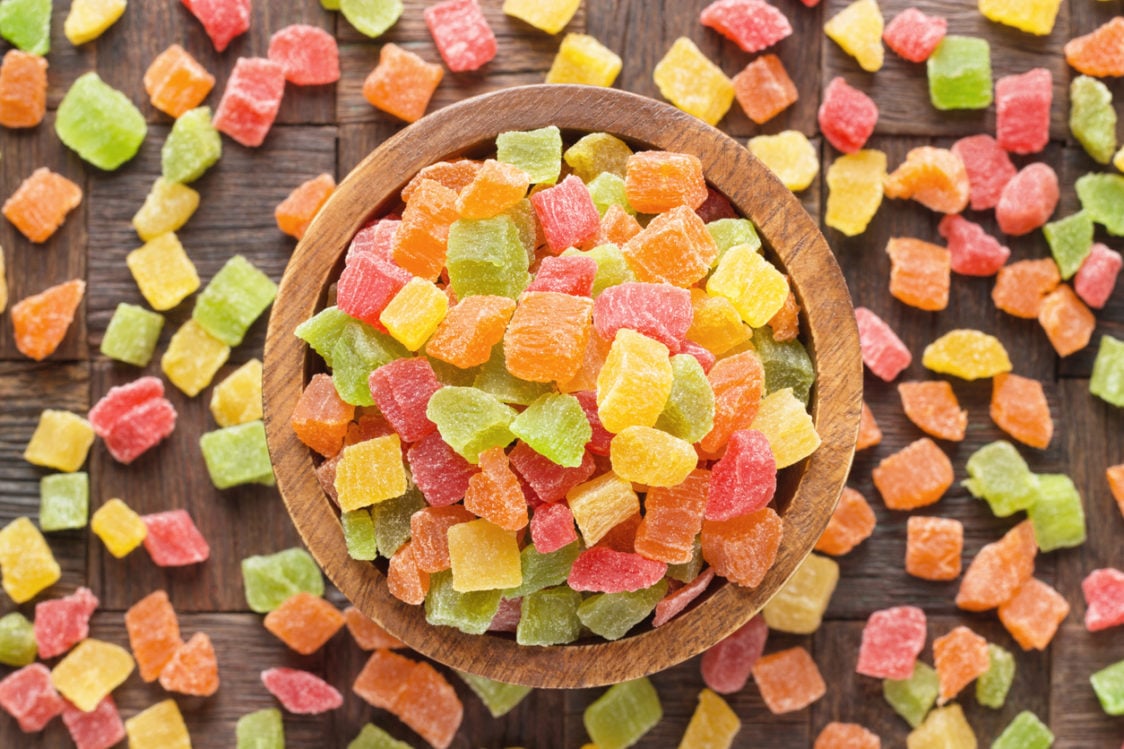
What to do about that?
It is quite simple in this case. Of course, you don’t have to avoid consuming dried fruit at all. All you need to do is control your intake given the total amount of calories you eat each day. In addition, try to choose dried fruit that does not contain any added sugar. Consuming dried fruit can be great, for example, as a source of energy on various trips. However, there are cases when it is better to consume fresh fruit as it higher water content and it can fill you up even more.
Conclusion
Each coin has two sides, and food is no exception. It is especially true with foods that only look healthy. For most of them, the problem is added sugar and high content of calories. In this case, it is definitely worth looking for the alternatives we have mentioned. Remember about moderate consumption in accordance with a balanced and comprehensive diet, and learn to choose better food options.
And how do you choose your food? If you liked the article, share it with your friends, so they can learn effective tips on how to recognize truly healthy foods.
[1] How Does Food Impact Health? – https://www.takingcharge.csh.umn.edu/how-does-food-impact-health
[2] Kris Gunnars - 20 Foods That Are Bad for Your Health – https://www.healthline.com/nutrition/20-foods-to-avoid-like-the-plague#TOC_TITLE_HDR_6
[3] Nizam Khan - 15 ‘Health Foods’ That Are Really Junk Foods in Disguise – https://www.healthline.com/nutrition/15-health-foods-that-are-really-junk-foods#15.-Most-processed-breakfast-cereals
[4] Hrefna Palsdottir - Breakfast Cereals: Healthy or Unhealthy? – https://www.healthline.com/nutrition/are-breakfast-cereals-healthy#tips
[5] Nutrition Bars: Healthy or Hype? – https://www.webmd.com/diet/features/nutrition-bars-healthy-hype
[6] What You Need to Know About Instant Oatmeal and Your Health – https://www.onegreenplanet.org/natural-health/what-you-need-to-know-about-instant-oatmeal-and-your-health/
[7] Franziska Spritzler - 10 ‘Low Fat’ Foods That Are Low In Nutrients – https://www.healthline.com/nutrition/10-unhealthy-low-fat-foods#TOC_TITLE_HDR_4
[8] Megan Ware - Everything you need to know about yogurt – https://www.medicalnewstoday.com/articles/295714#benefits
[9] Gerhard Braun - Fruit Juice and Nectar – Lots of Fruit and Nothing Else? – https://www.ua-bw.de/pub/beitrag.asp?subid=0&Thema_ID=2&ID=1738&Pdf=No
[10] Alina Petre - Is Fruit Juice as Unhealthy as Sugary Soda? https://www.healthline.com/nutrition/fruit-juice-vs-soda#nutrition
[11] Ansley Hill - Are Smoothies Good for You? – https://www.healthline.com/nutrition/are-smoothies-good-for-you#recipes
[12] Smoothies: Are They Good for You? – https://www.webmd.com/diet/smoothies-good-for-you
[13] Natalie Stein - The Skinny on Smoothies: Use with Caution! – https://www.lark.com/blog/the-skinny-on-smoothies-use-with-caution/
[14] Carolyn L. Todd - I'm Just Gonna Say It: Veggie Chips Are No More or Less Healthy Than Regular Chips – https://www.self.com/story/potato-chips-vs-veggie-chips
[15] Marissa Laliberte - Why You Should Stop Eating Vegetable Chips ASAP – https://www.thehealthy.com/nutrition/are-veggie-chips-healthy/
[16] Joe Leech - Agave Nectar: A Sweetener That’s Even Worse Than Sugar? – https://www.healthline.com/nutrition/agave-nectar-is-even-worse-than-sugar#production
[17] Is eating dried fruit healthy? – https://www.health.harvard.edu/nutrition/is-eating-dried-fruit-healthy
[18] Sally Wadyka - Is Granola Good for You? – https://www.consumerreports.org/granola/is-granola-good-for-you/
[19] Isabelle Aeberli, Philipp A Gerber, Michel Hochuli, Sibylle Kohler, Sarah R Haile, Ioanna Gouni-Berthold, Heiner K Berthold, Giatgen A Spinas, Kaspar Berneis - Low to moderate sugar-sweetened beverage consumption impairs glucose and lipid metabolism and promotes inflammation in healthy young men: a randomized controlled trial – https://academic.oup.com/ajcn/article/94/2/479/4597872
[20] Bovi, A. P. D., Michele, L. D., Laino, G., & Vajro, P. - Obesity and Obesity Related Diseases, Sugar Consumption and Bad Oral Health: A Fatal Epidemic Mixtures: The Pediatric and Odontologist Point of View.
[21] Ludwig, D. S., Peterson, K. E., & Gortmaker, S. L. - Relation between consumption of sugar-sweetened drinks and childhood obesity: a prospective, observational analysis. – https://doi.org/10.1016/S0140-6736
[22] A Guide to Buying Healthier Muesli From the Supermarket – https://goodnessme.com.au/blogs/news/a-guide-to-buying-healthier-muesli-from-the-supermarket
[23] Lustig, R. H. - Cukor - náš zabijak.
[24] Thuy, S., Ladurner, R., Volynets, V., Wagner, S., Strahl, S., Königsrainer, A. - Nonalcoholic Fatty Liver Disease in Humans Is Associated with Increased Plasma Endotoxin and Plasminogen Activator Inhibitor 1 Concentrations and with Fructose Intake.
[25] Jamie L. Willems and Nicholas H. Low - Major Carbohydrate, Polyol, and Oligosaccharide Profiles of Agave Syrup. Application of this Data to Authenticity Analysis – https://pubs.acs.org/doi/10.1021/jf3027342


Add a comment